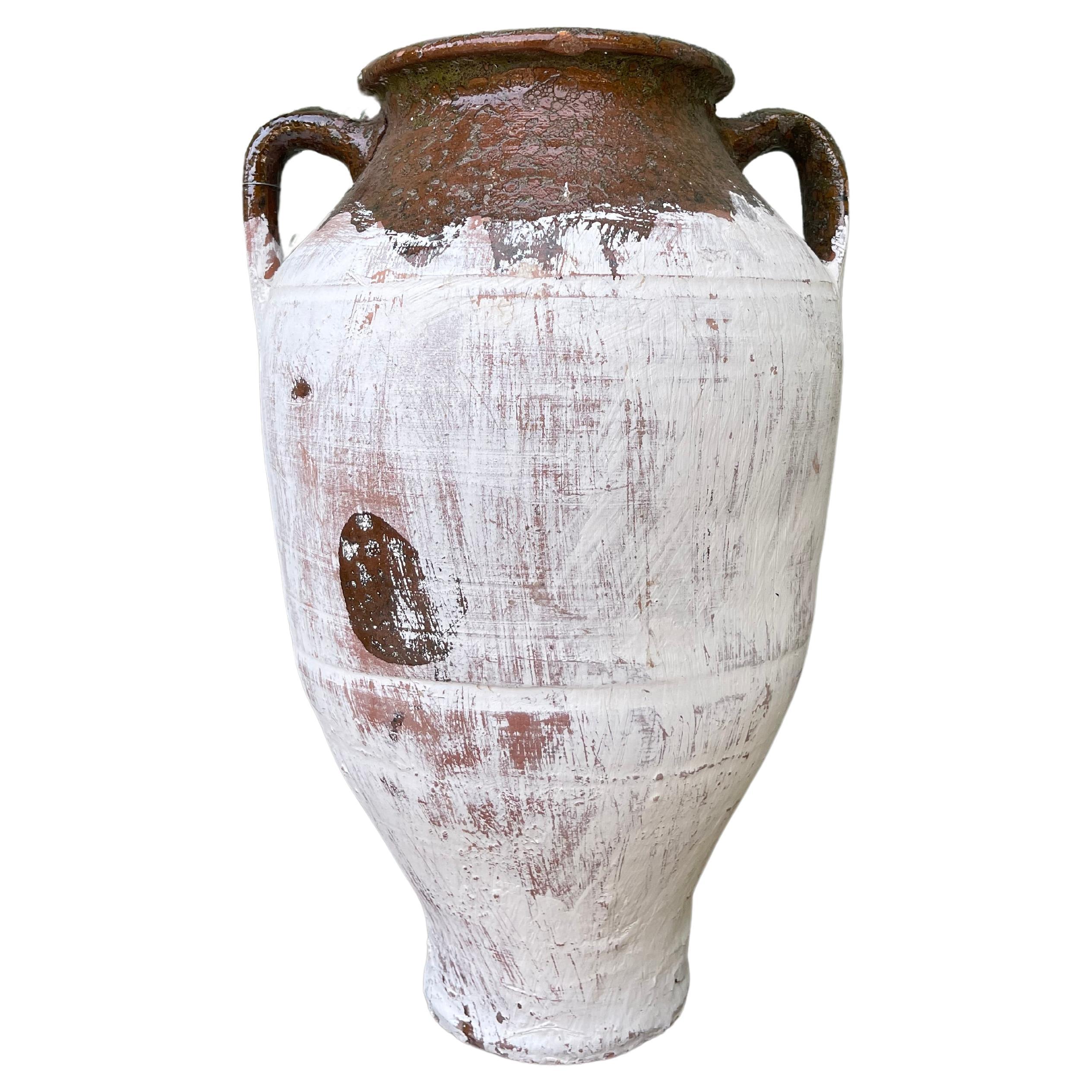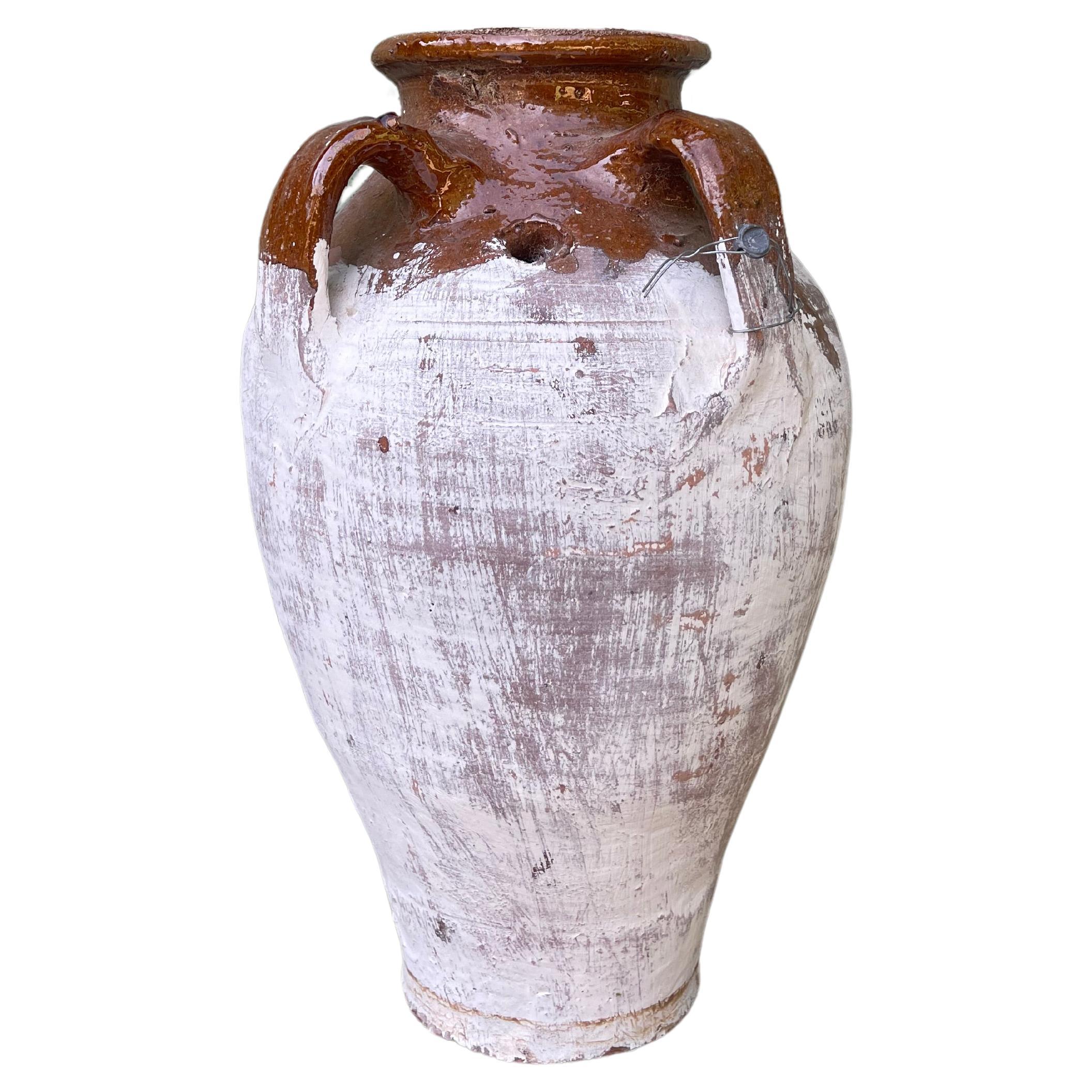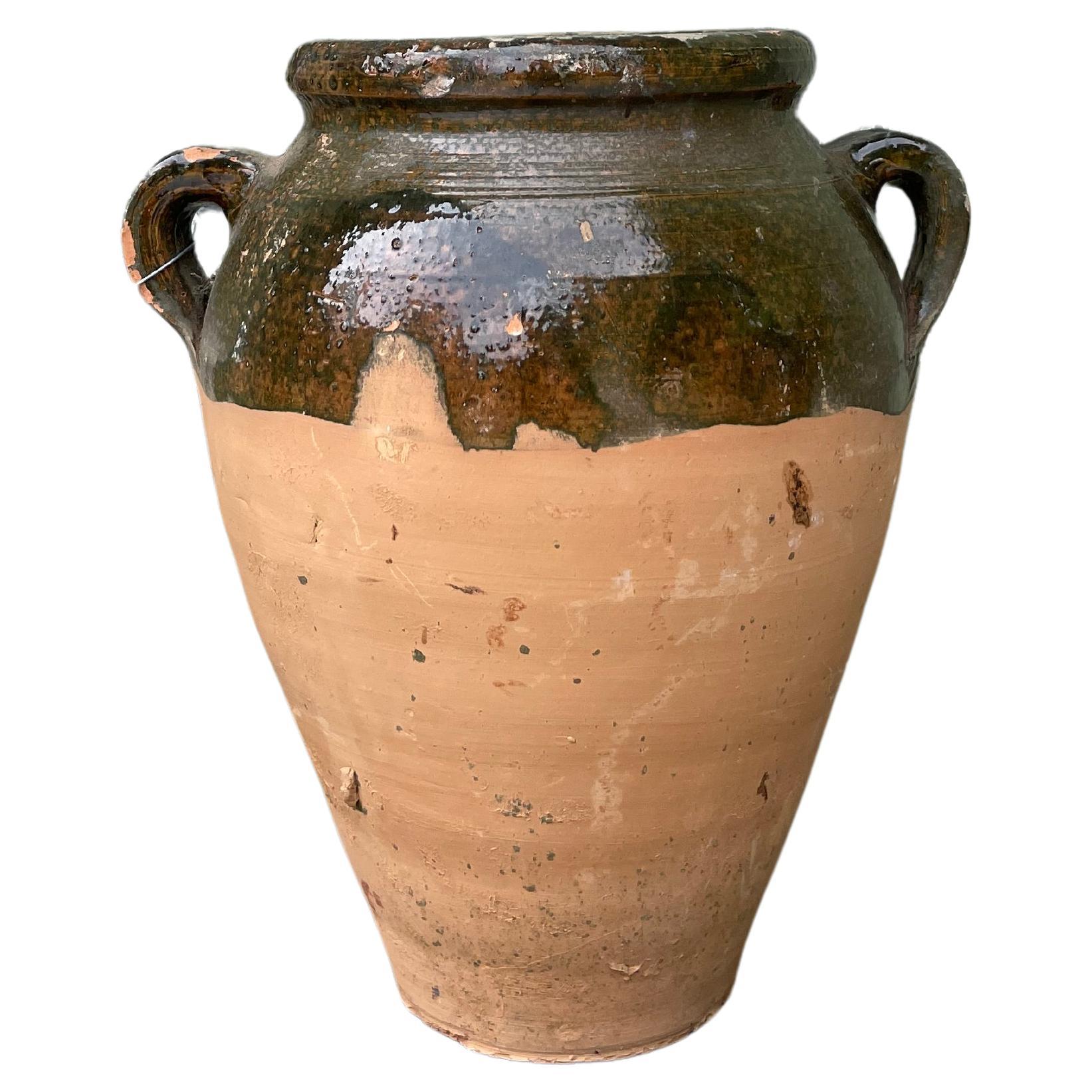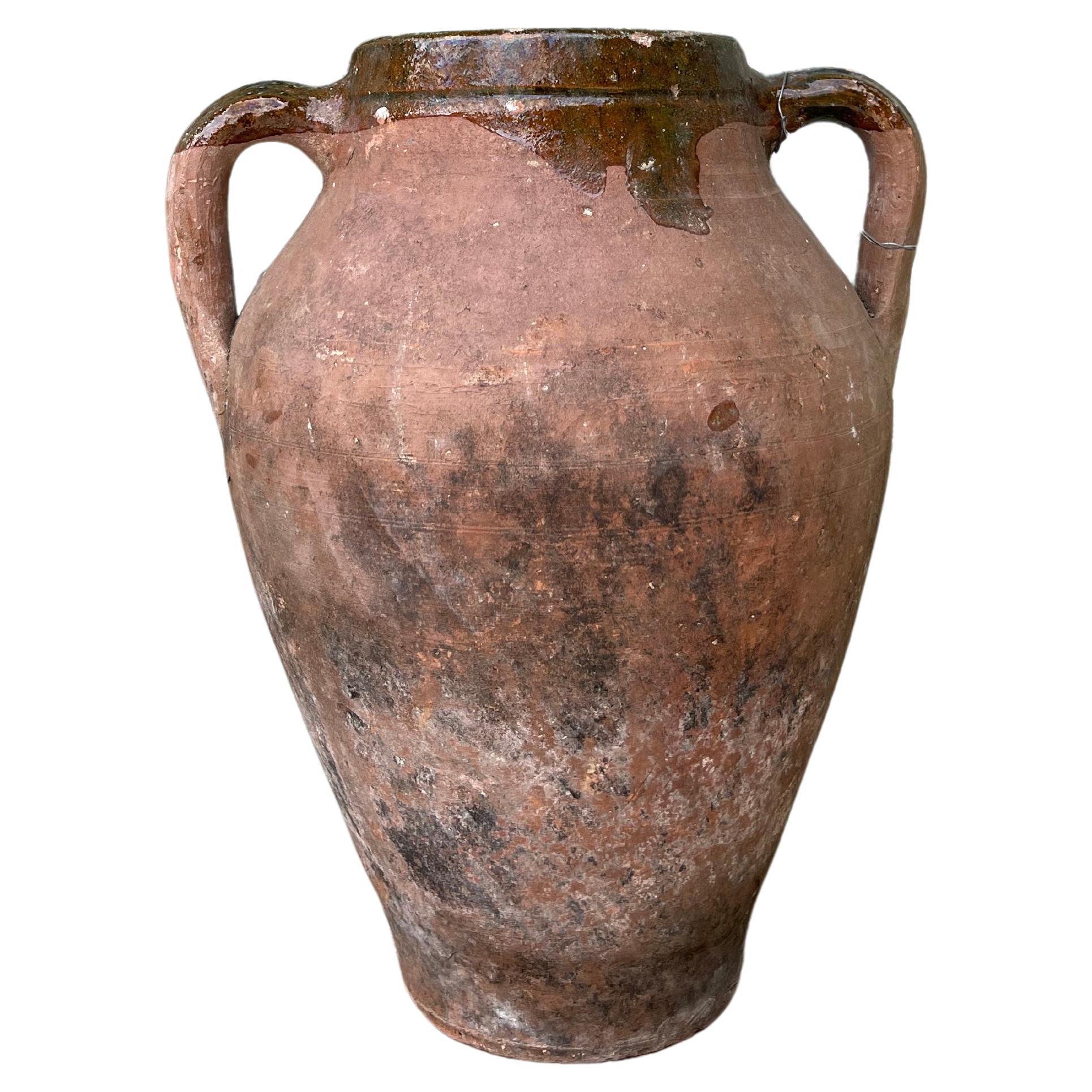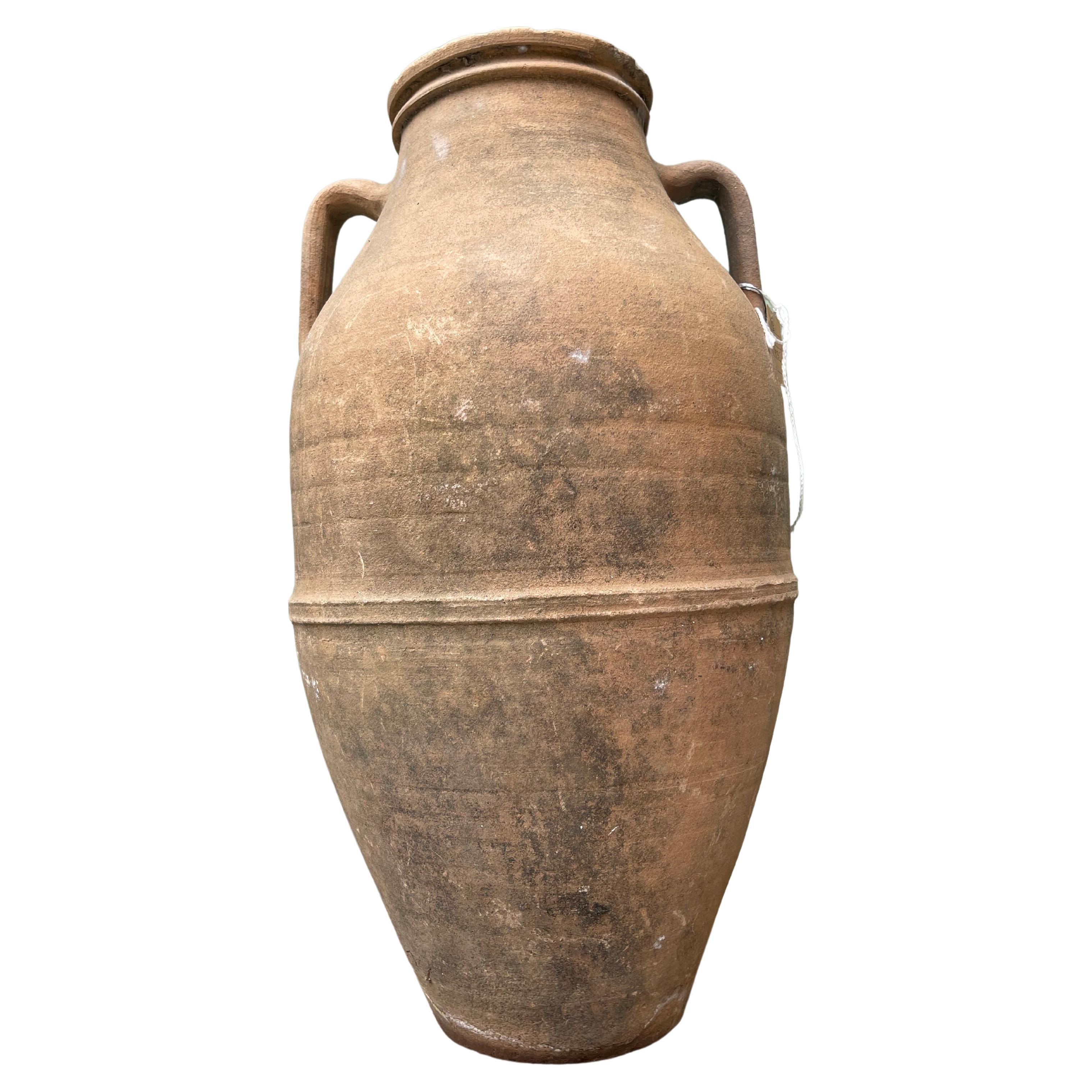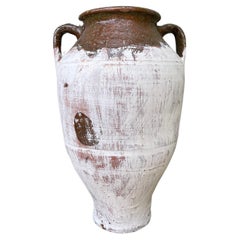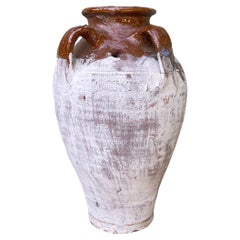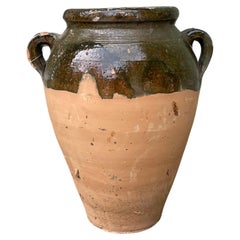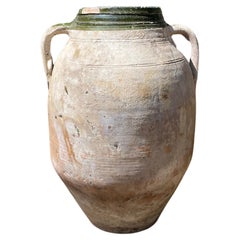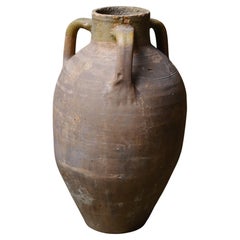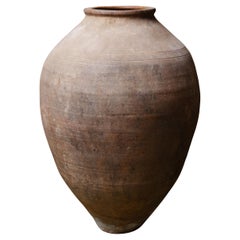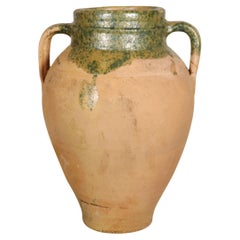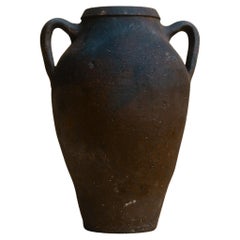Want more images or videos?
Request additional images or videos from the seller
1 of 7
Sırlı Küp (Turkish Glazed Jar - Medium)
$550
£415.07
€475.19
CA$775.68
A$851.60
CHF 444.28
MX$10,305.58
NOK 5,568.40
SEK 5,246.89
DKK 3,547.18
About the Item
This medium glazed and limewashed küp was likely used to store cheese by generations of families in the Levant. The design is similar to jugs used to carry water, wine, or other liquids (as cheese is traditionally stored in its brine). Glazing and lime-washing are techniques that has been used for centuries by Anatolian ceramicists to refresh, seal, and protect a clay vessel.
Cheese is a staple in most Turkish breakfasts today, with a fascinating history springing from the Fertile Crescent: the region of Southwest Asia that includes portions of present-day Turkey, Iraq, Iran, Jordan, Lebanon, and Syria. Around 8000 BCE, the first humans to keep livestock began firing pottery that could store dairy products in the warm climate. In this process, they discovered that they could use ceramic strainers to drain off the whey, creating cheese to enjoy fresh, to dry in the sun, or to salt & store.
One of the oldest urban centers of the world, Konya was the capital city of the Anatolian Seljuk Empire from 1060 until 1307. As the Anatolian Seljuks embellished their magnificent structures with colorful ceramic tiles, Konya became an esteemed global hub of ceramics (and remains so today). Rumi, the great 13th century Sufi poet, is buried in Konya.
*One-of-a-kind and marked by time, each of these pieces will show patina and natural imperfections. From oil stains to oxidation, we consider these alterations to be portals into a time long ago.
- Dimensions:Height: 18 in (45.72 cm)Diameter: 11 in (27.94 cm)
- Style:Greco Roman (In the Style Of)
- Materials and Techniques:
- Place of Origin:
- Period:
- Date of Manufacture:Unknown
- Condition:Wear consistent with age and use.
- Seller Location:Ojai, US
- Reference Number:Seller: SKU: 09161stDibs: LU9865241232342
About the Seller
No Reviews Yet
Vetted Professional Seller
Every seller passes strict standards for authenticity and reliability
Established in 2023
1stDibs seller since 2024
10 sales on 1stDibs
Typical response time: 7 hours
- ShippingRetrieving quote...Shipping from: Ojai, US
- Return Policy
Authenticity Guarantee
In the unlikely event there’s an issue with an item’s authenticity, contact us within 1 year for a full refund. DetailsMoney-Back Guarantee
If your item is not as described, is damaged in transit, or does not arrive, contact us within 7 days for a full refund. Details24-Hour Cancellation
You have a 24-hour grace period in which to reconsider your purchase, with no questions asked.Vetted Professional Sellers
Our world-class sellers must adhere to strict standards for service and quality, maintaining the integrity of our listings.Price-Match Guarantee
If you find that a seller listed the same item for a lower price elsewhere, we’ll match it.Trusted Global Delivery
Our best-in-class carrier network provides specialized shipping options worldwide, including custom delivery.More From This Seller
View AllSırlı Küp (Turkish Glazed Jar - Medium)
Located in Ojai, US
This medium glazed and limewashed küp was likely used to store cheese by generations of families in the Levant. The design is similar to jugs used to carry water, wine, or other liquids (as cheese is traditionally stored in its brine). Glazing and lime-washing are techniques that has been used for centuries by Anatolian ceramicists to refresh, seal, and protect a clay vessel.
Cheese is a staple in most Turkish breakfasts today, with a fascinating history springing from the Fertile Crescent: the region of Southwest Asia that includes portions of present-day Turkey, Iraq, Iran, Jordan, Lebanon, and Syria. Around 8000 BCE, the first humans to keep livestock began firing pottery that could store dairy products in the warm climate. In this process, they discovered that they could use ceramic strainers...
Category
Mid-20th Century Turkish Greco Roman Jars
Materials
Ceramic, Terracotta
Sırlı Küp (Turkish Glazed Jar - Medium)
Located in Ojai, US
This medium glazed and limewashed küp was likely used to store cheese by generations of families in the Levant. The design is similar to jugs used to carry water, wine, or other liquids (as cheese is traditionally stored in its brine). Glazing and lime-washing are techniques that has been used for centuries by Anatolian ceramicists to refresh, seal, and protect a clay vessel.
Cheese is a staple in most Turkish breakfasts today, with a fascinating history springing from the Fertile Crescent: the region of Southwest Asia that includes portions of present-day Turkey, Iraq, Iran, Jordan, Lebanon, and Syria. Around 8000 BCE, the first humans to keep livestock began firing pottery that could store dairy products in the warm climate. In this process, they discovered that they could use ceramic strainers...
Category
Mid-20th Century Turkish Greco Roman Jars
Materials
Ceramic, Terracotta
Sırlı Küp (Turkish Glazed Jar - Small)
Located in Ojai, US
This small "green-glazed" küp was likely used for wine, water, goat's milk, or cheese by generations of families in the Levant. The phosphorescent green glaze, a traditional techniqu...
Category
Mid-20th Century Turkish Greco Roman Jars
Materials
Ceramic, Terracotta
Sırlı Küp (Turkish Glazed Jar - Large)
Located in Ojai, US
This large "green-glazed" küp was likely used for wine, water, goat's milk, or cheese by generations of families in the Levant. The phosphorescent green glaze, a traditional techniqu...
Category
Mid-20th Century Turkish Greco Roman Jars
Materials
Ceramic, Terracotta
Sırlı Küp (Turkish Glazed Jar - Small)
Located in Ojai, US
This small "green-glazed" küp was likely used for wine, water, goat's milk, or cheese by generations of families in the Levant. The phosphorescent green glaze, a traditional techniqu...
Category
Mid-20th Century Turkish Greco Roman Jars
Materials
Ceramic, Terracotta
Sırlı Küp (Turkish Glazed Jar - Medium)
Located in Ojai, US
This medium glazed küp was likely used to store cheese by generations of families in the Levant. The design is similar to jugs used to carry water, wine, or other liquids (as cheese is traditionally stored in its brine). Glazing, a traditional technique on pottery wheels in Konya and Isparta, is as functional as it is beautiful. The glaze provides a protective and hygienic layer, making these objects optimal vessels for storing food staples and preserving delicacies.
Cheese is a staple in most Turkish breakfasts today, with a fascinating history springing from the Fertile Crescent: the region of Southwest Asia that includes portions of present-day Turkey, Iraq, Iran, Jordan, Lebanon, and Syria. Around 8000 BCE, the first humans to keep livestock began firing pottery that could store dairy products in the warm climate. In this process, they discovered that they could use ceramic strainers...
Category
Mid-20th Century Turkish Greco Roman Jars
Materials
Ceramic, Terracotta
You May Also Like
20th Century Rustic Anatolian Double-Handled Terracotta Jar
Located in London, GB
An exceptional piece of 20th-century Anatolian craftsmanship, this Turkish amphora features a distinctive triple-handled design that reflects its utili...
Category
Vintage 1940s Turkish Rustic Jars
Materials
Clay
20th Century Large Anatolian Terracotta Storage Jar
Located in London, GB
This 20th-century Anatolian terracotta storage jar represents the rich heritage of Turkish pottery, crafted with an emphasis on function and durability. Its expansive, bulbous form w...
Category
Vintage 1940s Turkish Rustic Jars
Materials
Clay
Antique Turkish Water Pot
Located in Leamington Spa, Warwickshire
Early 20th C Turkish water pot with a green glaze. 1900.
Internal reference: C
Code: 8494
Dimensions:
H: 15" (38.1 cm)
Di: 11" (27.9 cm)
Category
Early 20th Century Turkish Vases
Materials
Terracotta
Handcrafted Vintage Turkish Clay Jar, Rustic Pottery Vase
Located in London, GB
Bring timeless character to your space with this vintage Anatolian clay jar, a handcrafted vessel that reflects the rich pottery traditions of Anatolia. With its earthy tones, organi...
Category
Vintage 1940s Turkish Primitive Vases
Materials
Clay
19th Century Antique Ribbed Greek Olive Jar
Located in West Palm Beach, FL
A Greek olive oil jar with the typical handcrafted ribbed Nekuma decoration on its round bodice. The rim has a warm honey glaze. These antique garden p...
Category
Antique Late 19th Century Greek Jars
Materials
Terracotta
Mid-20th Century Handcrafted Turkish Clay Storage Jar with Natural Patina
Located in London, GB
Celebrate the understated beauty of Mediterranean craftsmanship with this Olive-Toned Tapered Clay Storage Jar, a 20th-century treasure from Anatolia. Originally designed for the pra...
Category
Vintage 1940s Rustic Vases
Materials
Clay
More Ways To Browse
Ceramic Turkeys
Ceramic Drainers
Ceramic Strainer
Blue And White Tobacco Jar
Ox Horn
Turkish Jug
Antique Pharmacy Apothecary Jars
Blue And White Double Happiness
Candy Display
Canister Set
Celadon Jar
Delft Tobacco Jar
Antique Chinese Blue And White Ginger Jars
Antique Chinese Blue White Ginger Jar
Jars With Birds
Qing Dynasty Jars
Salt Jar
Footed Jars
